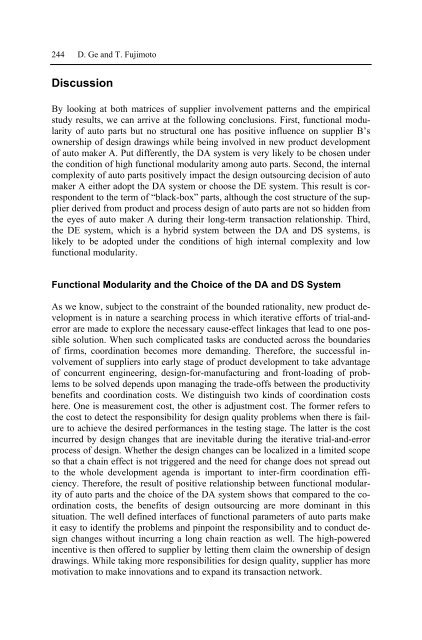Management of Technology and Innovation in Japan
Management of Technology and Innovation in Japan
Management of Technology and Innovation in Japan
You also want an ePaper? Increase the reach of your titles
YUMPU automatically turns print PDFs into web optimized ePapers that Google loves.
244 D. Ge <strong>and</strong> T. Fujimoto<br />
Discussion<br />
By look<strong>in</strong>g at both matrices <strong>of</strong> supplier <strong>in</strong>volvement patterns <strong>and</strong> the empirical<br />
study results, we can arrive at the follow<strong>in</strong>g conclusions. First, functional modularity<br />
<strong>of</strong> auto parts but no structural one has positive <strong>in</strong>fluence on supplier B’s<br />
ownership <strong>of</strong> design draw<strong>in</strong>gs while be<strong>in</strong>g <strong>in</strong>volved <strong>in</strong> new product development<br />
<strong>of</strong> auto maker A. Put differently, the DA system is very likely to be chosen under<br />
the condition <strong>of</strong> high functional modularity among auto parts. Second, the <strong>in</strong>ternal<br />
complexity <strong>of</strong> auto parts positively impact the design outsourc<strong>in</strong>g decision <strong>of</strong> auto<br />
maker A either adopt the DA system or choose the DE system. This result is correspondent<br />
to the term <strong>of</strong> “black-box” parts, although the cost structure <strong>of</strong> the supplier<br />
derived from product <strong>and</strong> process design <strong>of</strong> auto parts are not so hidden from<br />
the eyes <strong>of</strong> auto maker A dur<strong>in</strong>g their long-term transaction relationship. Third,<br />
the DE system, which is a hybrid system between the DA <strong>and</strong> DS systems, is<br />
likely to be adopted under the conditions <strong>of</strong> high <strong>in</strong>ternal complexity <strong>and</strong> low<br />
functional modularity.<br />
Functional Modularity <strong>and</strong> the Choice <strong>of</strong> the DA <strong>and</strong> DS System<br />
As we know, subject to the constra<strong>in</strong>t <strong>of</strong> the bounded rationality, new product development<br />
is <strong>in</strong> nature a search<strong>in</strong>g process <strong>in</strong> which iterative efforts <strong>of</strong> trial-<strong>and</strong>error<br />
are made to explore the necessary cause-effect l<strong>in</strong>kages that lead to one possible<br />
solution. When such complicated tasks are conducted across the boundaries<br />
<strong>of</strong> firms, coord<strong>in</strong>ation becomes more dem<strong>and</strong><strong>in</strong>g. Therefore, the successful <strong>in</strong>volvement<br />
<strong>of</strong> suppliers <strong>in</strong>to early stage <strong>of</strong> product development to take advantage<br />
<strong>of</strong> concurrent eng<strong>in</strong>eer<strong>in</strong>g, design-for-manufactur<strong>in</strong>g <strong>and</strong> front-load<strong>in</strong>g <strong>of</strong> problems<br />
to be solved depends upon manag<strong>in</strong>g the trade-<strong>of</strong>fs between the productivity<br />
benefits <strong>and</strong> coord<strong>in</strong>ation costs. We dist<strong>in</strong>guish two k<strong>in</strong>ds <strong>of</strong> coord<strong>in</strong>ation costs<br />
here. One is measurement cost, the other is adjustment cost. The former refers to<br />
the cost to detect the responsibility for design quality problems when there is failure<br />
to achieve the desired performances <strong>in</strong> the test<strong>in</strong>g stage. The latter is the cost<br />
<strong>in</strong>curred by design changes that are <strong>in</strong>evitable dur<strong>in</strong>g the iterative trial-<strong>and</strong>-error<br />
process <strong>of</strong> design. Whether the design changes can be localized <strong>in</strong> a limited scope<br />
so that a cha<strong>in</strong> effect is not triggered <strong>and</strong> the need for change does not spread out<br />
to the whole development agenda is important to <strong>in</strong>ter-firm coord<strong>in</strong>ation efficiency.<br />
Therefore, the result <strong>of</strong> positive relationship between functional modularity<br />
<strong>of</strong> auto parts <strong>and</strong> the choice <strong>of</strong> the DA system shows that compared to the coord<strong>in</strong>ation<br />
costs, the benefits <strong>of</strong> design outsourc<strong>in</strong>g are more dom<strong>in</strong>ant <strong>in</strong> this<br />
situation. The well def<strong>in</strong>ed <strong>in</strong>terfaces <strong>of</strong> functional parameters <strong>of</strong> auto parts make<br />
it easy to identify the problems <strong>and</strong> p<strong>in</strong>po<strong>in</strong>t the responsibility <strong>and</strong> to conduct design<br />
changes without <strong>in</strong>curr<strong>in</strong>g a long cha<strong>in</strong> reaction as well. The high-powered<br />
<strong>in</strong>centive is then <strong>of</strong>fered to supplier by lett<strong>in</strong>g them claim the ownership <strong>of</strong> design<br />
draw<strong>in</strong>gs. While tak<strong>in</strong>g more responsibilities for design quality, supplier has more<br />
motivation to make <strong>in</strong>novations <strong>and</strong> to exp<strong>and</strong> its transaction network.


